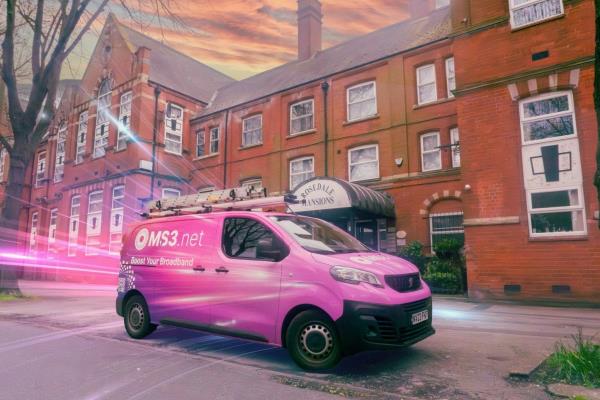27 November 2024
Guy Miller, CEO, MS3 Networks
Full fibre connectivity is more reliable than older types of connections such as ADSL and fibre to the cabinet. As digital access is now a precursory requirement for many educational and employment opportunities, full fibre plays a key role in improving living conditions.
Data from the Centre for Social Justice’s Left Out report highlights the ‘poverty premium’ that digitally excluded households pay as a result of not being able to shop around for the best deals online. According to the research, consumers without internet access pay an average of 25.5% more than digitally enabled customers for necessary expenses such as food, insurance and phone contracts.
With regards to opening up opportunities for disadvantaged people, the UK Government lists broadband speed as a key factor for attracting businesses to areas with historically less opportunity in its State of the Nation 2023: People and Places report.
Additionally, with the digital Universal Credit system now meaning claimants must apply online, internet access is key to being able to receive support with living costs.
Despite being one of the groups most in need of reliable connectivity, social tenants are also some of the least likely to have internet access — with around a third of all digitally excluded people living in social housing.
So, what are the challenges of installing full fibre broadband for tenants in MDU buildings, and how can broadband operators tackle them?
Installation issues
While digital exclusion has several complex and intertwining socioeconomic causes, a key reason why social tenants may not be able to access ultrafast broadband is because they live in an apartment block.
According to UK Government data, flats made up 30% of housebuilding completions for housing associations between 2021-2022, compared with only twelve per cent for private developers. Having a substantial proportion of the social housing stock comprised of MDUs can be challenging when it comes to installing broadband infrastructure.
As most full fibre network builds consist of running cabling underground or above ground via poles, the task of retrofitting MDUs can prove difficult for network operators. The added challenge of working out where to run the cabling through a multi-storey building has meant some providers have been less keen to install infrastructure within these residential units as it has not been economically viable.
An increasing number of network operators are now using discreet cabling that can be deployed down walls and skirting boards, both in communal areas and within tenant homes to facilitate the build.
On the other end of the spectrum, there has been reluctance from many housing associations and local authorities to make full fibre installation a priority. Post-Grenfell building safety concerns, as well as increased costs and pressure to decarbonise the housing stock, means that closing the digital divide has become less pressing for some providers. Consequently, they have not yet arranged full fibre access for all of their managed properties.
Although the introduction of the Telecommunications Infrastructure (Leasehold Property) Act (TILPA) in 2019 aimed to improve full fibre access for MDU residents, progress has been slow, especially for smaller MDUs.
A much more efficient way of ensuring full fibre access for tenants in local authority and housing association properties is through master wayleave agreements, which enable trusted broadband providers to install infrastructure within all premises under their management.
Access and affordability
Even when infrastructure is installed in MDUs, cost often acts as a barrier to access for many social housing tenants. Since multiple network installations can cause prolonged disturbances to tenants and increased building safety risks, in many cases, residents will only be able to access one provider’s broadband network within their property. If infrastructure is not shared with other operators, this can result in reduced choice and affordability for tenants.
Take the example of Hull, a mid-sized city in the East Riding of Yorkshire. According to 2021 Census data, Hull’s proportion of local authority renters stands at 18.9%, over double the national average of 8.3%.
Almost half of Hull residents live in the top 10% of deprived areas nationally, and of England’s 317 local authorities, Hull is the sixth most deprived for income and the seventh most deprived for employment.
Despite this, Hull has historically experienced some of the country’s highest internet prices due to the dominance of an incumbent operator that did not share its infrastructure at prices that were economically viable for new providers, resulting in limited choice and affordability for residents.
Broadband plans differ from other utilities in that costs are not closely tied to usage, making it difficult for users to save money by limiting the amount of internet used. Consequently, these high prices mean many households simply go without broadband when faced with cost-of-living concerns, a phenomenon that saw one million people disconnecting their broadband in 2022.
Alternative networks, or ‘altnets’ offer a viable way of ensuring that social housing tenants living in MDU properties can access full fibre and its benefits. By building their own independent ultrafast infrastructure, altnets offer tenants the opportunity to connect to their network through an internet service provider (ISP) partner, with social tariffs for the end customers who need it most.
Not only does being able to access multiple providers through one network limit disruption and safety issues in MDUs, but the increased competition also pushes prices down.
The progress social housing providers and network operators have made in rolling out full fibre infrastructure within MDUs is promising. But access goes beyond physical networks, and affordable pricing is key to ensuring social tenants can benefit from the full fibre networks installed in their buildings.










